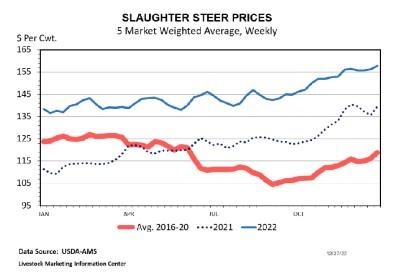By Kenny Burdine
Last week, Josh provided an overview of the 2023 cattle market. While he discussed the challenge of high grain prices, he largely wrote about a general optimism stemming from tighter cattle supplies as we start this new year. Without a doubt, most market fundamentals point to a considerably stronger cattle market across all sectors this year. This article will briefly discuss three questions that will be answered by the markets between now and spring.

How strong will fed cattle prices be?
If the cattle market had a pulse, that pulse would be cash cattle trade. Even in a feeder cattle state like Kentucky, one cannot downplay the significance of the fed cattle markets. They set the tone for the overall cattle market and deferred live cattle futures drive feeder cattle values through price expectations. Certainly, there are some risk factors that could impact beef demand this year, but there is little doubt that beef production will be down a great deal from 2022. As I write this, fed cattle prices are in the upper $150’s, but the April CME© futures contract exceeds $160. The higher the fed cattle market gets this spring, the more optimism there will be through the rest of the year.
How much smaller is this beef cow herd?
There is no doubt the beef cow herd shrank last year and the 2023 calf crop is going be much smaller. It’s really just a question of how much smaller the calf crop will be. Beef cow slaughter ran more than 10% higher last year and more heifers entered the beef supply chain. Culling was running very high as well – including the first quarter. So, we will likely see impacts on calf numbers this spring and fall. USDA will release their estimate of beef cattle inventory later this month, but it is hard to imagine that this calf crop won’t be at least 3% smaller than last year’s.
How far will this spring calf market run?
The calf market improved in 2022, but higher production costs kept most cow-calf operators from fully enjoying the price improvement. Reduced fall pasture growth and poor wheat grazing conditions also prevented the fall calf market from reaching levels it would have seen otherwise. As we move into spring, the impacts of expensive feed will be somewhat overshadowed by grazing opportunities. In truth, the calf market has improved quite a bit since fall. However, with fall 2023 CME© feeder cattle futures well above $2 per lb, we are likely to see calf price levels that we have not seen since 2015 once we start seeing some spring pasture growth.
Source : osu.edu